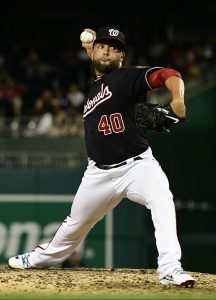The deadline for players and teams to exchange arbitration figures passed at 1pm ET yesterday, meaning over the next few hours, there will be a landslide of settlements on one-year deals to avoid an arbitration hearing. We’ll track today’s minor settlements from the American League in this post. Once all of the day’s settlements have filtered in, I’ll organize them by division to make them a bit easier to parse.
It’s worth mentioning that the vast majority of teams have adopted a “file and trial” approach to arbitration, meaning that once arbitration figures are exchanged with a player, negotiations on a one-year deal will cease. The two parties may still discuss a multi-year deal after that point, but the majority of players who exchange figures with their team today will head to an arbitration hearing.
As always, all salary projections referenced within this post are courtesy of MLBTR contributor Matt Swartz, and we’ll also be updating our 2019 Arbitration Tracker throughout the day…
Today’s Updates
- Yankees 1B Greg Bird will make $1.2 MM next season, per Bob Nightengale on Twitter.
- The controversial Roberto Osuna will make $6.5MM next season, per Feinsand. Teammate Jake Marisnick, who again scuffled in ’18 after a promising 2017, will make $2.2125MM.
- Per Mark Feinsand on Twitter, A’s lefty Sean Manaea $3.15MM in what’s sure to be an injury-marred 2019.
- Hard-throwing reliever Mychal Givens will make $2.15MM, per Eduardo A. Encina of the Tampa Bay Times (via Twitter), with additional incentives for making the All-Star team or placing in the Top-3 for the Rivera/Hoffman Reliever of the Year Awards, added MLB.com’s Mark Feinsand (via Twitter).
- The Mariners agreed on a $1.95MM deal with outfielder Domingo Santana, per MLB.com’s Greg Johns (via Twitter). Santana is the second and last of the Mariners’ arbitration-eligible players.
- The Angels agreed to contracts with a pair of players yesterday, per Maria Torres of the LA Times (via Twitter). Reliever Hansel Robles signed for $1.4MM. Robles threw 36 1/3 innings of 2.97 ERA baseball after the Angels claimed him off waivers from the Mets in June. Luis Garcia, acquired via trade from the Phillies this winter, signed for $1.675MM.
- The Tigers and reliever Shane Greene settled on $4MM, per USA Today’s Bob Nightengale (via Twitter).
- The Yankees reached an agreement with Sonny Gray for $7.5MM, per Nightengale. Gray, of course, has been involved trade rumors most of the winter, but for the time being, he stands to play a role in the Yankee pen while providing insurance for the rotation.
- Didi Gregorius has also come to an agreement with the Yankees on a one-year, $11.75MM deal in his final season before free agency, per USA Today’s Bob Nightengale (Twitter links).
- New Yankee James Paxton signed for $8.575, per Nightengale (via Twitter). Paxton is under contract for the 2020 season as well.
- The Houston Astros came to an agreement with Collin McHugh for $5.8MM, per Nightengale (via Twitter). McHugh could be moving back into the rotation after a stellar season in the pen, either way this will be his final season of arb eligibility before hitting the open market.
- Jonathan Villar comes away with $4.825MM for what will be his first full season in Baltimore, per Nightengale (via Twitter).
Earlier Updates


